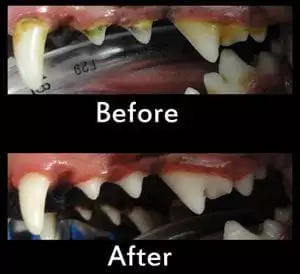Dog and Cat Periodontics in Boxborough
Dog and cat periodontics is the branch of dentistry that involves caring for the supporting structures of the teeth, including the gums. Periodontal (gum) disease is one of the most common oral conditions seen in pets. In fact, according to the American Veterinary Dental College (AVDC), more than 50% of all dogs and cats will have some form of gum disease by age 3. That’s why at Veterinary Dental Services, we’re pleased to have the advanced capabilities to diagnose, prevent, and treat this disease.

Pet Gum Disease
Gum disease is an inflammatory condition that’s caused by the body’s immune system response to plaque buildup on the teeth. There are four stages of gum disease, and in the most advanced stages, tooth loss occurs. Even in the early stages, inflammatory mediators and bacteria found in plaque circulate in the body and can lead to systemic disease. In dogs, an association exists between gum disease and changes in the heart, liver, kidneys, and lungs. Gum disease is characterized by a number of visible symptoms, including:
- Yellow/brown dental tartar or calculus on the teeth near gum line
- Swelling or reddening at the gum line
- Sensitive gums
- Bad breath
- Loose teeth
However, it’s important to keep in mind that gum disease can be insidious, and many pets won’t show symptoms until the disease has progressed.
How Dog and Cat Gum Disease is Diagnosed
Diagnosing gum disease involves the following basic steps:
- Oral examination
- Dental cleaning
- Digital dental X-rays

The second step of diagnosing gum disease involves digital x-rays and sometimes cone beam CT scanning. This technology allows us to view below the gum line to determine the extent of bone loss, which can be a symptom of gum disease.
Treating Pet Gum Disease
Pet periodontics involves not just diagnosing gum disease, but treating it as well. Here at Veterinary Dental Services, we have a variety of approaches to treat various stages of periodontal disease:
- Ultrasonic scaling or cleaning to remove plaque and calculus
- Root planing and subgingival curettage, which involves the removal of residual calculus and smoothing an irregular tooth root surface to treat root exposure or pockets
- Pocket treatment with a perioceutic product with the goal of increasing attachment and diminishing pocket depth
- Gingivectomy, the surgical removal of diseased or overgrown gums
- Periodontal flap surgery to eliminate pockets or cover exposed roots
- Guided tissue regeneration surgery to regenerate bone and other attachment tissues, with the goal of saving teeth and preventing jaw fractures
- Extractions
- Surgery to close oronasal defects caused by severe bone loss in advanced stages of gum disease
